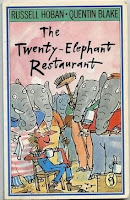Sometimes books come along to test boundaries
Magpies Volume 31, issue 2, page 32.When I read a book from our school library my mind often wanders to thoughts of which student might enjoy it. Magrit is almost impossible to categorise. While I did enjoy Magrit it is such an odd book and at times feels quite harsh and dark. Some reviewers suggest age 10 but I think this is really a book for a very senior primary student and certainly one who has read quite widely.
The setting for Magrit is a cemetery. Magrit lives there with her 'friend' Mister Puppet. Magrit herself created Mr Puppet.
"Magrit had pieced him together from elements she had found in every corner of the graveyard : a bone here, a stick there, a tin can in one corner and rotten twine from a garbage bag in another. Now he sat at the apex of the roof, with his long arms wrapped around the stone cross, and kept vigil."
Mr Puppet is the voice of doubt, the voice of reason perhaps the voice of authority. He gives Magrit advice which is presented in a bold hand drawn font.
When a stork drops a tiny baby into the graveyard Mr Puppet orders Magrit to kill it but she does not. Instead she nurtures and cares for the tiny infant. She finds ways to feed, clothe and wash her new 'friend' and gives him the name Bugrat. Through care of this child Magrit discovers love and finds happiness. There is, however, one dark corner of the graveyard Magrit never visits. Everything changes when Bugrat learns to walk and sets of exploring. He wanders over to the forbidden place and finds the skeleton of a young girl and Magrit is distraught.
"It was a small skeleton, obviously a child, curled up on its side as if sleeping, with its legs drawn up towards its chest and arms folded as if hugging a non-existent teddy ... Magrit realised that the whole world had fallen silent ... The murmur and hum that always emanated from the surrounding buildings, so prevalent that she never really noticed, was painful in its absence ."
You can read more of the plot here.
Watch this short video to hear the author Lee Battersby from Western Australia talk about Magrit. I am not sure that I would read this book with a class but here are a set of teacher notes from Walker Books which might give you some further insights into this complex and yet compelling book.
Magrit is a unique book but it does have some links with The Graveyard book, The Unfinished Angel and perhaps Skellig.
You can read some reviews here by clicking these quotes:
Themes include resilience, responsibility and independence, wrapped up in a suspenseful and fantastical mystery.
Magrit has plenty of soul, sadness, despair, and hope. It’s a delightfully dark fairy tale, full of Battersby’s whimsy and charm.
Magrit is a wonderfully crafted story that is magical, unusual, strange and captivating. I haven’t read anything quite like it before.






























